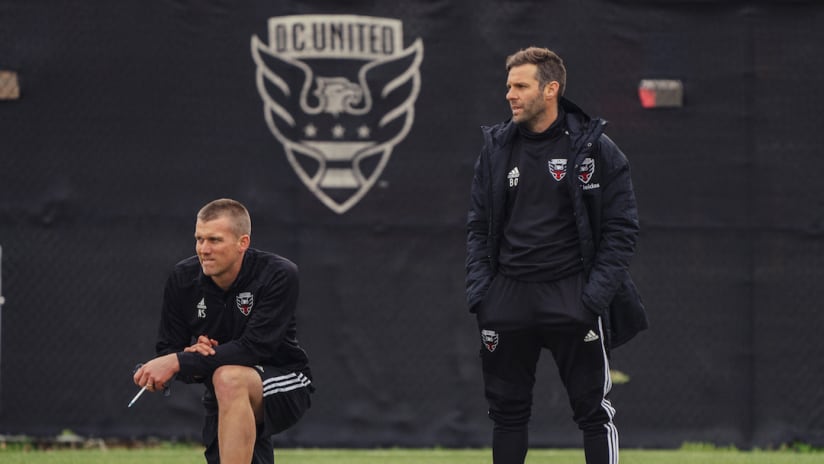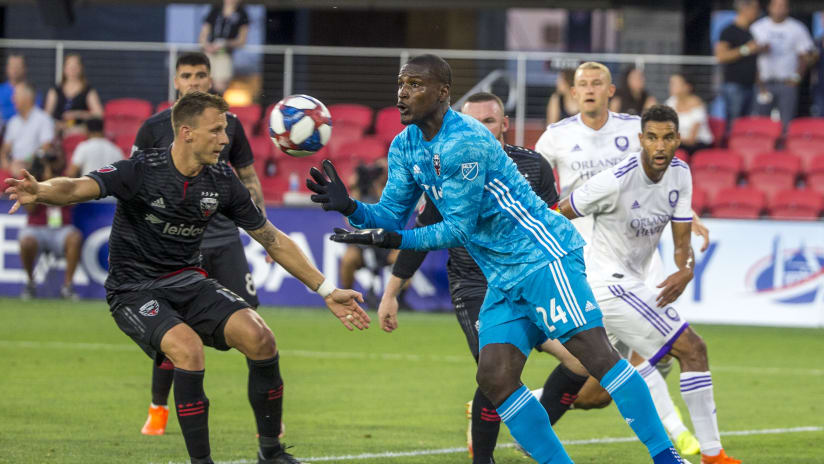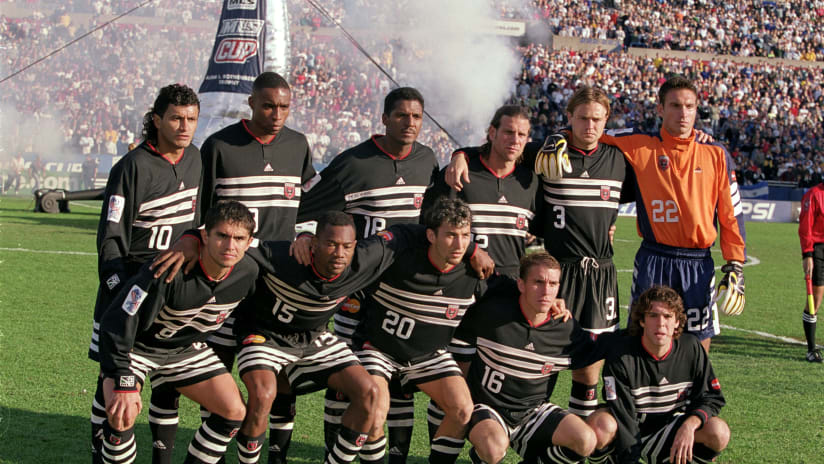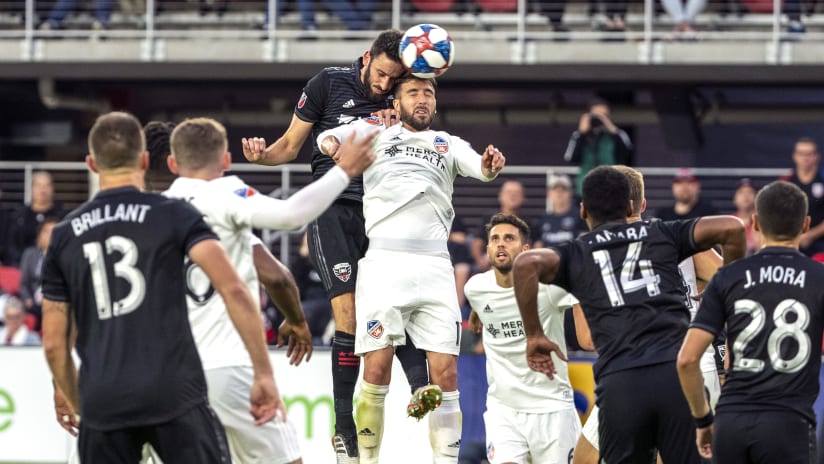Ben Olsen is screaming. With his three-quarters Adidas pants rolled to mid-thigh and his hat slipping sideways with sweat, the D.C. United coach is seething over his own misplaced touch in a close-range shooting drill with goalkeepers Bill Hamid and Chris Seitz during Thursday’s training session. “Ahhhhh!” Olsen bellows as he retreats to the top of the box for another rep, another attack on goal, another chance to blast his lingering frustrations from Sunday’s trouncing by the Philadelphia Union into orbit, with each successful strike serving as cathartic relief.
The net bulges as he smashes a left-footed shot past the keeper at the near post. Then he switches feet and places a curler in the upper-right corner. This, it seems, is Olsen’s therapy.
“Thanks coach,” says director of goalkeeping Zach Thornton as the drill concludes.
Four days earlier, following a 5-1 defeat that would sink United to fifth in the Eastern Conference standings, Olsen acknowledged the divergent paths his team now faced. With only two wins since May 12 and a goal tally in the bottom third of the league during that span, the Black-and-Red were treading water in a logjammed playoff picture. Olsen knew the next few days would likely define his team’s season as the transfer deadline loomed and a marquee game against the LA Galaxy scheduled for Sunday night. How his group responded to last week’s shellacking would answer the question of sink or swim, playoffs or bust.
“We need to figure out how we tweak this because right now we’re not good enough,” Olsen said during his post-match press conference last Sunday. “We’ve got to make some changes. That could be tactical, that could be personnel. So we’ll take a look at that.
“It’s an interesting time for us because we can go two ways from here. This is a moment. This is a game where we can respond and have a real charge at this, or we could go the other way. So we’ll see what I’m made of and we’ll see what the group is made of.
“You have to be careful addressing teams after (games like) this. Sometimes it becomes more about me letting off steam than actually benefitting the group. I’ve managed to somewhat find that balance, but sometimes yelling at your team after the game is selfish. Today was partly about the team and partly just selfish.”
At that moment, though, an exhaustive week was just beginning.
Monday, August 5, 1:24 p.m.
Calls and texts are pinging from Audi Field to team employees around the city, with the message unchanged from one interaction to the next: Get to the stadium as quickly as possible. There is major news involving Wayne Rooney, the face of D.C. United’s franchise.
Slowly but surely, word trickled through the organization about Rooney’s decision to leave the club following the 2019 season. He had agreed to a deal as player-coach with Derby County of the English Football League Championship and will be returning home in January, during the next transfer window, to embark on another chapter of his career. And with 30 minutes until he and his agent, Paul Stretford, must leave for the airport in Washington — Rooney will be introduced by Derby County in England the following morning — he arrives in the interview room at Audi Field to record a video explaining both his decision to leave and his commitment to United for the remainder of the year.
“The opportunity came up for me to join Derby County in January, as a player but also as a coach, which was important to start that transition for the next stage of my career, which I’ve always showed that desire of that’s what I want to do,” Rooney said. “But also for my family and myself to be back in England around our extended family and friends was part of the reason also. So that opportunity came about, and I felt it was the right opportunity for me at this time.”
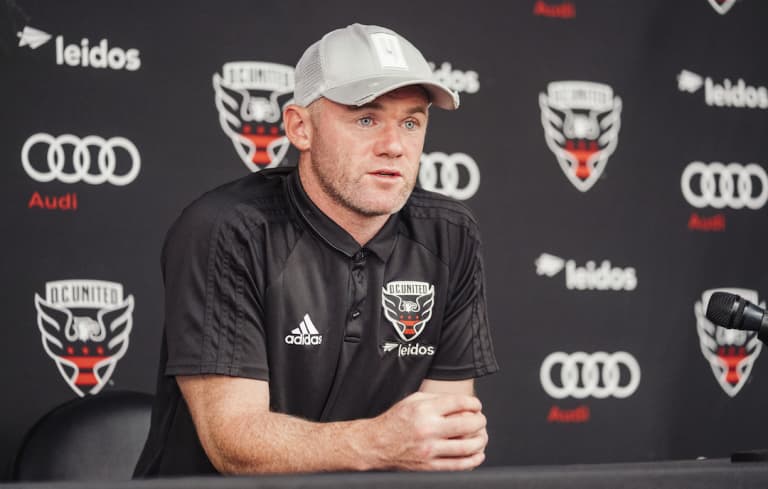
For as sudden and blindsiding as the news seemed to the general public, coaches and executives at D.C. United had a little more advanced notice, though it still wasn’t much. General manager and vice president of soccer operations Dave Kasper said the team first learned of this possibility about a week prior, at which point Rooney was on the verge of arriving in Florida for the MLS All-Star Game. It afforded the team a momentary head start on the final stages of the transfer window, during which their priorities shifted from building around Rooney, who would have had two years remaining on his contract after this season, to straddling a middle ground between positioning themselves for a 2019 playoff run while simultaneously stockpiling talent for their Rooney-less future.
“It actually made us go after things a little harder, to be honest with you,” Kasper said earlier this week. “The biggest thing with Wayne is when he first met with Ben (Olsen) and I was getting an agreement that he would finish out the year so he could go out the right way and we could have time to plan for the next transfer window in January looking for his replacement.
“Obviously it’s disappointing. We put a lot of work into it. We were very happy with how things ended up last year. We’ve had some bumps in the road this year. We need to finish strong, and I think we can do that with the group we have now and with the pieces we’re adding. We can make a real push here.
“So listen, as a general manager I can’t get emotionally wrapped up in short-term situations. You’ve got to always think long term. So when something like this happens, you just have to go on to the next thing and start planning and rebuilding. The moves this summer were in part for now but also planning for our future as well.”
As Rooney crossed the pond Monday evening for his formal introduction with Derby Country, whose executive chairman, Mel Morris, described the signing as “incredible,” Kasper and his staff worked late into the night procuring reinforcements with nine games remaining in the regular season. By the time Rooney returned to training Thursday morning — with plans to host a players-only dinner later in the week — three new faces were waiting to greet him inside the dressing room: striker Ola Kamara, winger Emmanuel Boateng and central midfielder Felipe Martins.
Taken together, Rooney hoped the new signings would jolt United into a playoff run.
“Obviously the last few games haven’t been good enough,” Rooney said, “but we’re in a position where we can still rise up the table and even have a shot at finishing first in the Eastern Conference. We have to believe in ourselves. We have to show confidence that we can do that. And if we do that, at our best we know we’re capable of beating anyone.”
Tuesday, August 6, 11:10 a.m.
As his team returned to training for the first time since Sunday’s loss, Kasper paces the sidelines of RFK Stadium Auxiliary Field with cell phone in one hand and coffee in the other, alternating between calls and texts. He hadn’t slept much the night before as United reached agreements in principle for all three players the team planned to acquire.
But in Major League Soccer, where a voluminous rulebook further complicates the murky transfer waters, the actual procurement of players is never as simple as consummating said agreements. The details are muddied by General Allocation Money (GAM), which is an annual allotment of money that is available to clubs independent of their salary budgets and can be used for various purposes, and Targeted Allocation Money (TAM), which are funds strategically provided by the league so teams can add or retain players who will make an immediate impact on the field. The best general managers make shrewd uses of both.
So with those two tools at his disposal, Kasper authored four additional trades in order to facilitate the acquisitions of Kamara, Martins and Boateng.
- For Kamara: The deal itself featured a $2.5 million transfer fee paid to Kamara’s club, Shenzhen F.C., of the Chinese Super League. But because Kamara had previously played in MLS for both the Galaxy and Columbus Crew, the Black-and-Red needed to jump atop the Allocation Ranking Order in order to claim him. To do this, Kasper sent $100,000 in 2019 GAM, $100,000 in 2020 GAM and the No. 11 spot in the Allocation Ranking Order to the Colorado Rapids, who held the top spot.
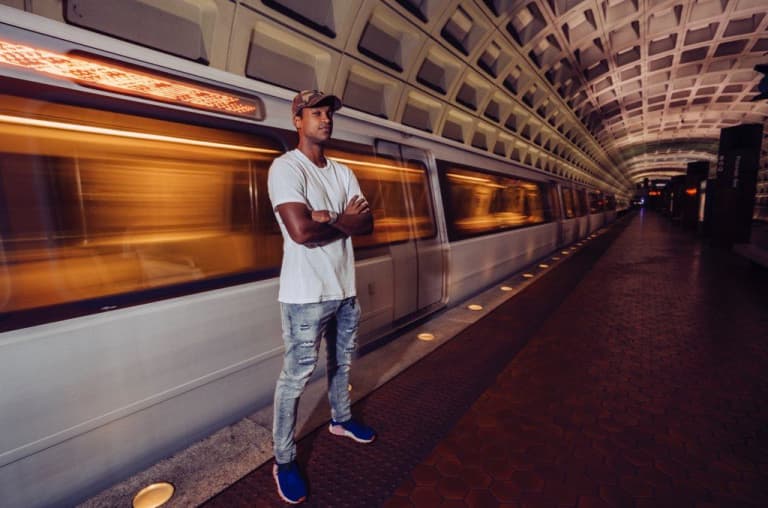
Executing a deal with a Chinese club proved difficult because of the time difference. Kasper said the exchange of information between the two sides took twice as long as a normal deal, with significant lapses in communication each day.
“I would be up earlier and stay up later than normal,” he said. “I’ll get up at 3, 4, 5 o’clock in the morning and check my phone, go back to sleep.”
- For Boateng: The deal itself was a simple trade between United and the Galaxy, with the former sending $250,000 of TAM in exchange for Boateng. But this deal required Kasper to make three additional moves in order to compile the necessary kitty of TAM.
First, he traded an international roster spot to Minnesota United FC in exchange for $50,000 in GAM. Then he flipped that GAM — plus another $12,500 of his own GAM and an additional international roster spot — to the Portland Timbers in exchange for $212,500 in TAM. And finally, Kasper traded $50,000 in GAM to the Crew in exchange for $50,000 in TAM. Only then did Kasper have enough TAM to pay the Galaxy for Boateng.
“It’s all in here,” Kasper said, pointing to his head when asked how he keeps track of so many dollar amounts. “I’ve been doing it so long that I can spin a lot of plates. There’s a lot going on.”
- For Martins: The deal itself was another simple trade between United and Vancouver Whitecaps FC, with the former sending $75,000 in 2020 TAM and a 2020 international roster spot in exchange for Martins. This deal took two or three hours to complete, according to Kasper, and was the simplest of his three acquisitions.
“We were a little tight on cap space this year, so they’re going to hold all of his salary cap (charge) above the minimum salary (because) we have a minimum salary spot available,” Kasper said. “And we give them next year a 2020 international spot and 75K of TAM. Some of our existing players are in the pipeline to get Green Cards, so we feel good about parting with that spot.”
Interestingly, United hadn’t compiled a list of central midfield targets prior to last week’s game against the Union. But when two more players were lost at that position — Chris Durkin (ankle) and Junior Moreno (red card) — in addition to the prior loss of Russell Canouse (lung), there was suddenly a need for improvisation.
“We had to act quickly,” Kasper said. “We had an idea of who may be available because there’s a lot of talk that goes on once the transfer window opens. There’s a lot of daily conversations with every GM: Do you want this player? Do you want that player? What are you looking for? So we kind of knew Felipe was available, and he’s a guy we’ve kind of had our eye on for some time.”
Part of the reason United pursued these players in particular was their collective familiarity with MLS, a league that carries significant differences in travel and competition from other parts of the world. With nine games remaining in the regular season, Kasper sought players whose adjustment time with United would be minimal, and in Kamara, Boateng and Martins he found three players with a combined 14 seasons of professional soccer experience in the United States.
“These are three guys that know our league,” Kasper said. “We feel they will adapt very quickly. We needed guys who were ready to go into an MLS game and know what it’s like to play in various stadiums and what the level is like in our league.
“We need to get in the playoffs, that’s the first step. We can’t get ahead of ourselves. Once we’re in the playoffs it’s a matter of now getting on a run and getting our confidence. This team can go far, but the first step — obviously we don’t want to put the cart before the horse — we’ve got to get in the playoffs, and that’s the focus now.”
Wednesday, August 7, 11:46 a.m.
Four days after his arrival, Kamara is still yawning. The 29-year-old had flown from China to the United States over the weekend in two legs: the first took him from Shenzhen Bao’an International Airport to Los Angeles International Airport, where he was greeted with a four-hour delay. The second took him from Los Angeles to Washington D.C. in time to watch Sunday’s match against the Union at Audi Field.
“It was 24 hours of travel,” said Kamara, who also navigated 12 time zones.
With his $2.5 million transfer fee, Kamara became the second-richest signing in club history behind winger Paul Arriola, who cost United more than $3 million when he joined Club Tijuana in 2017. Such a fee will feel like a bargain, though, if Kamara can recapture his goal-scoring from during three prior seasons in MLS, one with the Galaxy and two with the Crew. He netted 49 goals in 88 games from 2016-18 for an average of one goal every 1.79 games, a strike rate United would do backflips for during the final two months of the regular season.
Things had soured quickly for Kamara following his $3.5 million move to Shenzhen in February. He appeared in just five games for his new club and never scored, contributing but one assist in 450 minutes. His family, which had relocated to China when Kamara first moved, departed after two months and left him alone in a country where he did not speak the language. Kamara understood it was better to move home sooner than later.
“I spoke to my agent early in June,” Kamara said. “I know I had some options but I wanted something exciting and something that could be maybe a little bit more long term, especially because I want to stay somewhere and get my kid and family somewhere they’re safe and comfortable and everything. So the total package here I felt was the best thing for me.
“I loved being in MLS from the start. I’ve seen a lot of MLS since I went to China and I know that DC has done very, very good. Good players and also the new stadium. I know there’s a new training facility (in the works as well), so the infrastructure in the club is very good and I think it’s attractive football being played in DC.”
It proved to be a favorable move for United as well — at least on paper. Kasper said Kamara accepted less money than his prior MLS contract to rejoin a league he dominated after a disappointing stint in China. The reduced wages, combined with Kamara’s desire to find a home for the foreseeable future, made for an easier sell to co-chairmen Jason Levien and Steve Kaplan.
“We have a good communication line amongst owners and myself and Ben (Olsen), so everyone is on the same page,” Kasper said. “It’s typically presenting opportunities like that to ownership and justifying what to spend. Ola is interesting because he took a pay cut to come back to the league, a big pay cut. So while we spent $2.5 million on the transfer, he’s making a lot less money than he did with the Galaxy. We look at this as like a three-year complete deal, and it ended up being three-and-a-half years.”
Identifying transfer targets in need of fresh starts was another common theme for Kasper’s deadline week spending spree. Boateng, 25, had played a career-high 2,322 minutes in 2017 before watching that number erode by more than 50 percent last season. He had logged just 882 minutes for the Galaxy in 2019 and entered the window hoping to receive an opportunity elsewhere.
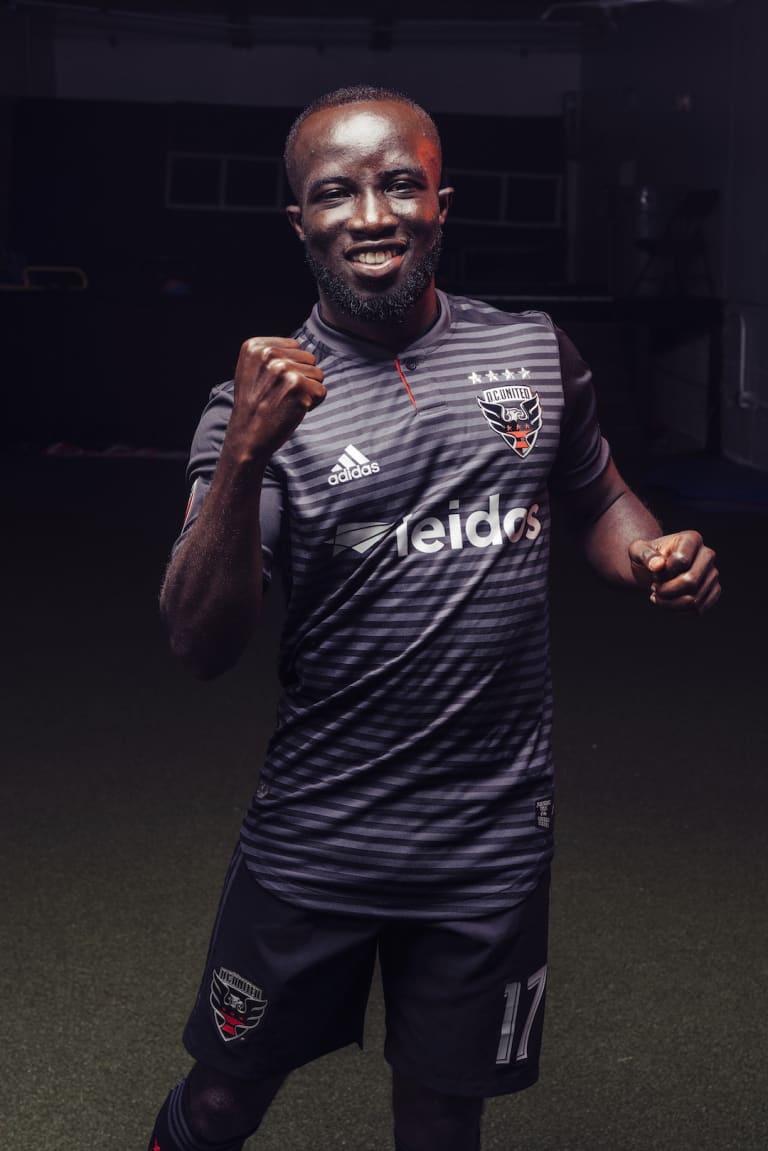
Across the Galaxy dressing room, players understood the club was negotiating a massive transfer deal for Boca Juniors and Argentinian starlet Cristian Pavon, the finances of which would require several higher-salaried veterans to depart. Boateng said several players attended a barbeque Monday in Los Angeles and joked that the event might double as a going-away party because of Pavon’s impending arrival.
“Oh yeah,” Boateng said. “We knew.”
As his minutes decreased, Boateng was angling for a transfer as early as last season, only to have those aspirations rebuffed by the Galaxy. This year, Boateng said, teammate Chris Pontius had shown him the transfer rumors on Twitter regarding D.C. United, and he wound up being called into the coach’s office a few hours later.
“I walked in and they told me D.C. is really interested in having me there, and they’re thinking about a deal, so we’re about to sign everything,” Boateng said. “And I was like, ‘Well if they want me there, then I want to be there too.’ It’s somewhere that I’m being valued and given a chance to play. So if D.C. wants me there, it’s a good place, it’s a good team and everything. I thought I’d go there and try to help the team.
“I knew there were teams that were interested, but teams have been interested for the last year and a half, and the Galaxy keeps saying no. So my thing was I wasn’t sure if the Galaxy was going to let me go. But I knew there were a few other teams that wanted to have me there. I was actually surprised when D.C. came to an agreement. And now I know why: It makes sense because (the Galaxy) had to make room for a big signing they were about to make (in Pavon).”
Martins, 28, was another player who had fallen out of favor this season, igniting a similar desire for change. Since joining MLS in 2012, Martins had averaged 31.3 appearances per year for the Montreal Impact (2012-14), New York Red Bulls (2015-17) and the Whitecaps, his most-recent employer. But as that number dipped to just 13 appearances in 2019, he embraced the idea of finding a new club, though Martins assumed it wouldn’t happen until next season.
“If you look at all my years in the league and being consistent playing so much, this year I didn’t play as consistently as I would like,” Martins said. “So for me it was good, you know, to get a fresh start and come back to actually the East Coast and the U.S. It was very positive. My family is happy because they had a tough time adapting in Vancouver. So when it happened, it was very positive. It happened really quick, but I felt right away really good.
“I was hoping but I didn’t think it would happen now. I thought it would happen at the end of the season. ... You go from not being in a playoff spot (in Vancouver) to being in a playoff spot (in D.C.), so I think it’s a positive thing, especially coming here, a great team that has proved over the years to be a top club.”
Given the personnel issues in central midfield — where United will be without Canouse, Moreno and Durkin for Sunday’s game against the Galaxy — Martins is expected to start in the middle of the park, though Olsen’s preferred formation remains unclear. What excites Kasper and Olsen is the ruggedness with which Martins plays the game, his aggression on the field offering a pleasant juxtaposition to an exceedingly polite demeanor off of it. Martins is eager to make a strong first impression Sunday before returning to Vancouver to face his old club next weekend.
And in the meantime, between now and the trip to Vancouver, Martins plans to buy D.C. United jerseys for his children.
“It’s very exciting to be here,” he said.
Thursday, August 8, 11:07 a.m.
Ben Olsen is transfixed. With his team scrapping its way through an 11-on-11 drill, roasting beneath the late-morning sun, Olsen is more vocal than he’s been the last few weeks in training. He shouts encouragement from the touchline, implores certain players to run harder and commends a series of intricate passing that results in a quality chance for the team in orange bibs.
Perhaps this is what Olsen referred to after losing to the Union when he said “we’ll see what I’m made of” during the final playoff push. Perhaps this is what he meant by assessing whether his team needed the carrot or the stick to break out of its summer slumber.
Two days earlier, and while Rooney was being introduced at Derby County across the pond, Olsen held court for more than 20 minutes with a handful of reporters inside a conference room at RFK Stadium. Honesty and introspection defined the conversation, with Olsen admitting his coaching staff had been challenged tactically “more than ever to get outside of our comfort zone because of our team and the circumstances around it,” as injuries and suspensions and the inability to field a steady lineup gnawed at the erasers in the team’s classroom.
He acknowledged the ongoing tug of war between micro and macro focuses, between identifying the group that gives United the best chance to beat the Galaxy this weekend while understanding that, in the larger view of the final nine games, that same starting 11 might not be the right choice in terms of building for the future. He promised the coaching staff had been logging plenty of hours in the “war room” experimenting with various combinations on the white board. And then he conceded that those explorations won’t be solidified in the next week, meaning Sunday could be the source of further self-reflection.
“Every season has moments,” Olsen said. “It’s a time to pivot, and I think there’s a few different ways to pivot. The challenge is to make sure that it’s in a positive way. That doesn’t mean you’re positive with each other, right? It means maybe we’re a little moody and there’s a little hostility in the locker room, and that’s all part of this moment. It’s about right now, I think, having everybody understanding what they bring to this team and the responsibility of them bringing the best they can bring consistently, and that hasn’t happened and it hasn’t happened enough in some of the bigger games, some of the moments in the games that have had the hype.
“We’re asking more out of each player and also myself. I have to figure out as well what the best group going forward is — and right now I’m not sure. I think that’s some stuff that we’ll figure out over the next couple days, in terms of how we want to look going into the next couple months so that we can make this run we all want to see.”
And when it’s all said and done — when the regular season ends and Rooney departs and there has been a proper evaluation period for the three new signings — this will surely be a week that defines United’s season.
The only question is how.

